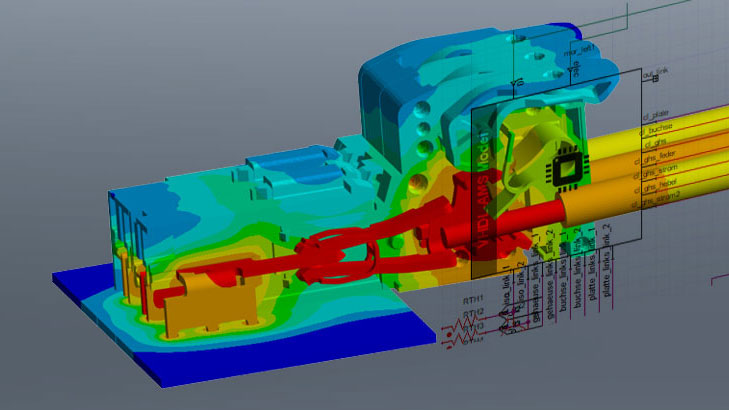Sustainability through digital integration of material data, CAD, PLM, and simulation
Marc Vidal
25.03.2025
Optimize products for ecological metrics early in the development phase
Design for Sustainability optimizes products from the very earliest development phase, taking into account ecological, economic and functional aspects. Tools such as Ansys Granta, CAD and PLM allow materials, processes and variants to be efficiently evaluated. A digital mesh of these systems enables reliable results and accelerates sustainable product development. In this article, you will learn what successful Design for Sustainability is and how sustainability can be implemented in practice through data-driven decisions and simulations.
In the very early phase of product development, as much as 70 to 80% of a product's final properties can already be determined. In its Sustainability Product Policy1, the European Union also emphasizes that around 80% of a product's ecological footprint is defined in the design phase. This is precisely where digital engineering and design for sustainability come into play.
Studies frequently discuss to what extent the development of sustainable products can be aligned with economic goals (e.g., CRI_world-in-balance-2024_13112024_web.pdf2). Another important consideration is the risk of greenwashing, where the ecological footprint is merely calculated rather than genuinely embedded in the product design.
Design for Sustainability is not about calculating the ecological footprint at the end of the product development process. Instead, it's about optimizing the product with regard to ecological metrics at an early stage of development. Digital engineering and simulation have been established methods for decades for optimizing products in terms of function and cost at an early stage. Design for Sustainability extends these methods to include sustainability aspects. This allows an optimal design to be created that combines economy, performance and sustainability. As an integral part of the design process, it ensures that products meet the desired characteristics while also supporting business objectives.
How can D4S be integrated into the company?
The first step in integrating design for sustainability into a company is determining which factors have the greatest influence. These factors may include selecting more environmentally friendly materials, material savings, and resource savings in production, logistics, and operations. Other factors include optimizing the product life cycle and designing efficient recycling processes. The factors that have the greatest effect depend on the individual circumstances.

Factors for driving sustainable product design | © CADFEM Germany GmbH
Ansys Granta: a consistent and fully traceable solution
The tools and methods for optimizing products regarding the aforementioned factors are available in digital engineering. In many cases, the choice of materials and their influence on production processes and logistics plays a central role in determining the final ecological footprint. In order to compare different variants correctly at an early stage of development, a consistent link between ecological, economic and technical material data with the EBOM (Engineering Bill of Materials: a list of all the components required to manufacture a product) is required.
Ansys Granta is a material knowledge management system that handles all this data, provides reference data and ensures digital consistency with CAD and PLM. A digitalized, consistent and always traceable solution like this is highly efficient and reliable. This makes it possible to implement Design for Sustainability as early as the design phase.
Optical simulation
Precision & efficiency combined. Find out in our webinars and further information how you can develop your optical designs with maximum precision.

Ansys Startup Program: simulation for startups
Take advantage of the best in simulation technology, right from the start of your business, with a reduced investment.

Recommended reading
Together with Prof. Benjamin Schleich, we have developed a guide for implementing D4S in medium-sized companies.
.png)
Linking the lists of parts with production processes and transportation data
A key question for practical implementation is how well this can be integrated into a heterogeneous system landscape. In product development, PLM, CAD, and CAE tools from different vendors are often used together. To ensure data consistency and traceability, Ansys Granta is equipped with various interfaces that can be adapted to specific requirements. To demonstrate this capability, we have developed a workflow for Design for Sustainability within a sample heterogeneous system landscape. In this setup, Ansys Granta serves as the material knowledge management system, integrated with PTC Creo for the design process and Aras as the PLM tool.

Design for sustainability workflow with Ansys Granta in a representative CAD/PLM landscape | © CADFEM Germany GmbH
How the Design for Sustainability process works in this example:
-
Material Preselection: Granta is used to select suitable materials from a vast range of reference data based on ecological and economic criteria.
-
Variant Creation in Creo: Different design variants are created in Creo, and the corresponding materials from Granta are assigned. The BOM Analyzer in Creo is already used at this stage to compare variants.
-
Simulation in Ansys: The functionality of the different variants is validated and optimized through simulation in Ansys.
-
Integration with Aras PLM: Aras, as the PLM system, links the bill of materials (BOM) from Creo with manufacturing processes and transportation data. Using this complete dataset, the BOM Analyzer performs a precise comparison of the variants regarding their CO2 footprint and resource consumption.
This delivers results within seconds, making it usable at any time in the engineering process to ensure the right development direction is taken as early as possible. By seamlessly integrating data from CAD, PLM, and Granta, the process becomes automated, reliable, and scalable. New design variants can be created with minimal effort while still meeting development goals. Additionally, using centralized data sources ensures that all subsequent development steps are based on the same consistent dataset.
The example not only shows the procedure but also demonstrates how quickly Design for Sustainability can be implemented in daily engineering tasks. The deliberate connection to various tools in the system landscape shows the tool independence of Ansys Granta and is an example of how Granta can be used as a central management tool for all types of material data in any company environment.
Systematic Selection of Materials using Ansys Granta Selector
Learn how to derive material properties from product requirements and how to find suitable materials in a structured and reliable way.

How to reduce material consumption & waste in product development
Learn briefly and compactly how you can sustainably reduce material consumption and waste in product development using digital engineering. (in German)

Restricted substances: Material Selection and Data Management for simulation and production
Material Selection and Data Management help companies comply with regulatory requirements, optimize material selection, and integrate material knowledge in the processes.





